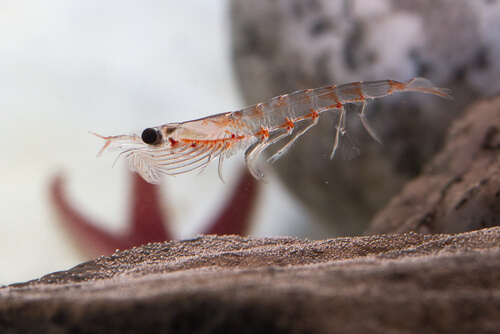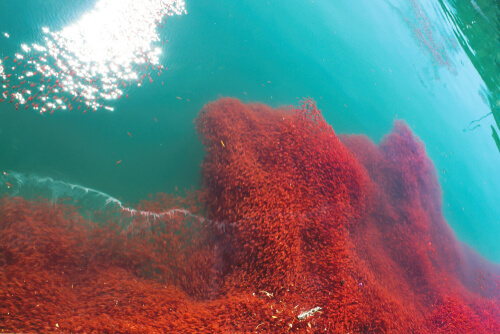
| Kingdom | Animalia |
| Phylum | Arthropoda |
| Class | Malacostraca |
| Order | Eucarida |
| Family | Euphausiidae, Bentheuphausiidae |
| Genera | Euphausia, Meganyctiphanes, Nematobrachion, Nematoscelis, Nyctiphanes, Pseudeuphausia, Stylocheiron, Tessarabrachion, Thysanoessa, Thysanopoda, Bentheuphausia |
| Species | 85 species |
| Niche | Primary consumer |
| Length | 2 in (4.5 cm) |
| Weight | 0.07 oz (2 g) |
| Lifespan | 10 years |
| Social Structure | Swarming |
| Conservation Status | Uncertain |
| Preferred Habitat | Marine ecosystems |
| Average Clutch Size | 10,000 eggs |
| Main Food Items and Prey | Phytoplankton |
| Predators | Fish, birds, baleen whales, whale sharks, humans, etc. |
The Basics
Krill are a group of 85 species of small, swarming shrimp-like crustaceans found throughout the world’s oceans. Despite their small size, they are a highly important part of the food chain, providing food for hundreds of other species that directly feed on krill. This includes large baleen whales such as the blue whale.
General
The word krill is Norwegian in origin and refers to 86 species of small shrimp-like arthropods of the families Euphausiidae, in which there are 9 genera, and Bentheuphausiidae, in which there is only one genus.

Krill are small, shrimp-like decapod crustaceans. Like all crustaceans, they have a hard, chitinous exoskeleton. Like all decapods, their bodies can be separated into three segments. The cephalothorax is comprised of the head and thorax of the animal, which are fused. The final section is the pleon, which includes the ten swimming legs and the tail fain, which aids in swimming as well. In most species, their exoskeleton is translucent, allowing for some of the animals’ organs to be observed in vivo.
They also have round, black, compound eyes prominent on the front of their heads, along with two antennae and a pair of thoracic legs known as thoracopods. As opposed to the swimming legs of the pleon segment, thoracic legs include some used for feeding and others used for grooming. In general, they appear quite similar to a small crayfish, lobster, or shrimp, but grow to a maximum length of two inches and a weight of less than one ounce. Unlike true shrimp, however, krill have externally visible gills.
Habitat and Distribution
Krill occur throughout the world’s oceans, although not all species have a global distribution. Many species are frequent in shallow waters in the photic zone where they can feed on phytoplankton. Most species undertake a diurnal migration from deeper waters in the day where they can hide from predation to more shallow waters at night, where they can access the species on which they feed while still under cover of darkness.

Diet
Many krill species are filter feeders, using their most forward thoracic legs to make a comb-like structure they use to filter food from the water around them. In many species, these filters are highly specific and will catch mostly diatoms and other unicellular phytoplankton. Other species are omnivorous and will feed on different species of phytoplankton as well as some zooplankton. Some other krill species are carnivorous, feeding strictly on planktonic animal species such as larval fish and other copepods.
Predators
Krill are a highly important species in the global food chain as they are one of the primary ways in which the energy available in algae becomes available to the rest of the food chain, generally larger animals that otherwise aren’t able to feed on minuscule algae. Krill are often very abundant and tend to school together, meaning that many of them can be caught at once. This has made them a primary part of the diet of baleen whales, some of the largest animals on the planet. Penguins, seals, many fish species, and more will also feed directly on krill.
Life Cycle
After a new egg hatches, most krill species will develop through about five larval stages. During the first three of these, yolk reserves within their body nourish the larvae. By the later stages, a mouth and digestive tract will have developed and they will begin to feed on phytoplankton. By this time, the larvae must have reached the photic zone, the area in the ocean where light reaches and thus phytoplankton bloom. Like other crustaceans, they will molt repeatedly as they develop, replacing their exoskeleton each time they outgrow it.
Most krill species mate by the deposition of a sperm sac to the female’s thelycum. Females may carry thousands of eggs and may produce multiple broods during one breeding season. Once fertilized, some species such as members of the genera Bentheuphausia, Euphausia, Meganyctiphanes, Thysanoessa, and Thysanopoda will ‘broadcast spawn’, effectively releasing their eggs freely into the water. In other species, known as ‘sac spawners’, females will carry the eggs around with her. They are attached to the rearmost pair of thoracic legs until they hatch as matenauplii, the third of five typical krill larval stages.
Some species of krill such as Euphasia superba that live in higher latitudes may live for over six years while most tropical species will live for only two years or less. They will usually breed during their first breeding season, which usually coincides with the summer months.
Conservation Status
Most krill species do not receive any special protection for conservation. However, they are clearly a highly important part of global food chains and their complex ecology must be carefully considered in regions of high pollution or where the impacts of global climate change are currently greatest. For example, in some cases where pollution can cause algal blooms, this can impact the entire food chain. If these blooms affect the composition of the phytoplankton community where they occur, they may limit food availability for krill, many of which feed on very specific types of algae. If the krill population suffers from such an event, many other animals higher up the food chain will also suffer. In Norway, events like these have been determined to contribute to occasions on which salmon fail to spawn, due likely to the lack of food availability in these regions.
Fun Facts about Krill!
Krill form the basis of the diet of hundreds of other species. This includes the blue whale, the largest animal that has ever lived. This is just one fun fact about this highly fascinating and important species.
Truly Fish Food
Not only are krill one of the primary food items for hundreds of other species in the wild, but they are also fished commercially by humans. The total global harvest of krill, an animal that weighs no more than 0.07 ounces, is around 150,000-200,000 tonnes every year. In some countries such as Spain, Japan, Russia, and the Philippines, these are consumed by people. For example, in Japan, they are known as okiami, while in Spain they are referred to as camarones, the general word for shrimp.
However, most of this commercial catch is not consumed by humans but instead is used for fish feed in commercial aquaculture operations as well as home aquariums. The krill are dried and packaged, being fed to captive fish, just as they often are in the wild.

A Primary Consumer
Krill species are considered an important part of the food chain and occupy a foundational trophic level. They mostly feed on phytoplankton – primary producers that transform the energy of sunlight into organic matter. This makes them a primary consumer – animals, usually herbivores, that feed on plants and thus make their energy available to the rest of the food chain. Krill, for example, are the main source of food for many larger animals such as baleen whales.
In the Southern Ocean, one species – the Antarctic Krill (Euphausia superba) – has a biomass of around 418,000,000 tons, making it one of the most abundant species on the plant in terms of biomass. Over half of this biomass is eaten by whales, seals, penguins, squid, and various fish species, many of which are important commercial species.
In this way, krill allow the energy arriving on earth via sunlight to be converted from plant material to animal material. In turn, this makes this energy available to many other species, including some of the largest animals on the earth such as the blue whale. Needless to say, the disruption of the ecosystems that sustain these krill species would likely reap negative consequences for many other species, humans notwithstanding.
Not Like the Others
Although krill are often generally referred to as one type of animal, there are 86 species of different krill across two families. Of these, 85 of them fall within the 10 genera in the Euphausiidae family. The remaining species Bentheuphausia amblyops is the only genus of the family Bentheuphausiidae. Unlike many other krill species, B. amblyops lives in deep waters below 3,300 feet. At this depth, it is a cosmopolitan species, being found in all of the world’s oceans. It is also the most primitive species of krill. This makes it important in understanding the evolutionary position of these animals which share traits with both decapods and mysids.
Bioluminescent
Besides B. amblyops, all species of krill are bioluminescent, having organs known as photophores that can emit light. This light is generated by a reaction within these organs that catalyzed by an enzyme. For example, luciferin – a specific pigment – is activated by a luciferase enzyme.
Fascinatingly, studies indicate that the luciferin of many krill species is a fluorescent tetrapyrrole, similar but not identical to the luciferin found in dinoflagellates, a group of phytoplankton that is also capable of bioluminescence and commonly consumed by krill. This suggests that the krill do not produce this substance themselves but acquire it as part of their diet.
Krill photophores are complex organs with lenses and the ability to be focused and rotated by muscles. The exact evolutionary function of these organs remains unclear, but possibilities include mating, social interaction, or orientation. They may also act as a form of counter-illumination camouflage to compensate for their shadow against overhead ambient light. In some bioluminescent animals, it is believed that the bioluminescence may act as a defense against predation, effectively distracting and disorienting their predator, particularly in low-light conditions such as at night or in the deep sea.
